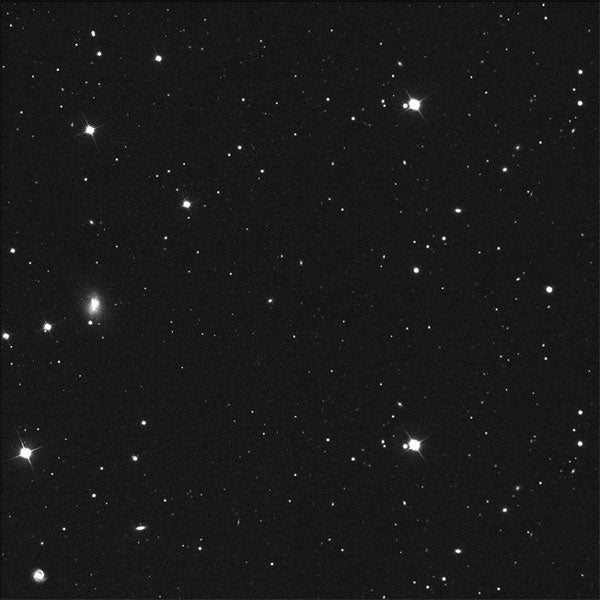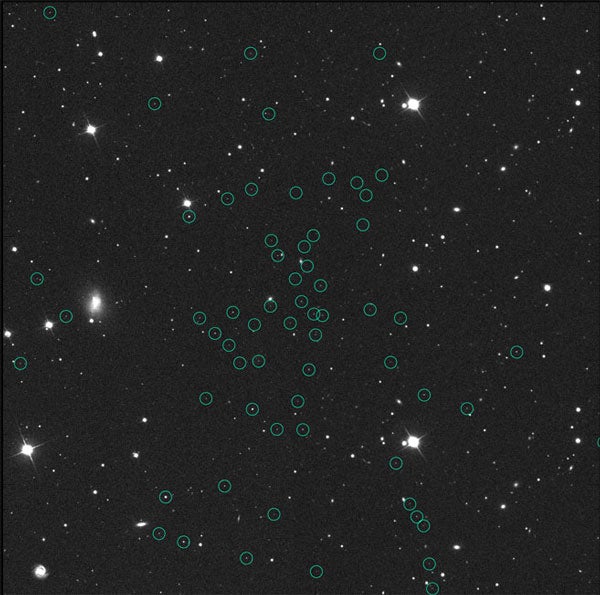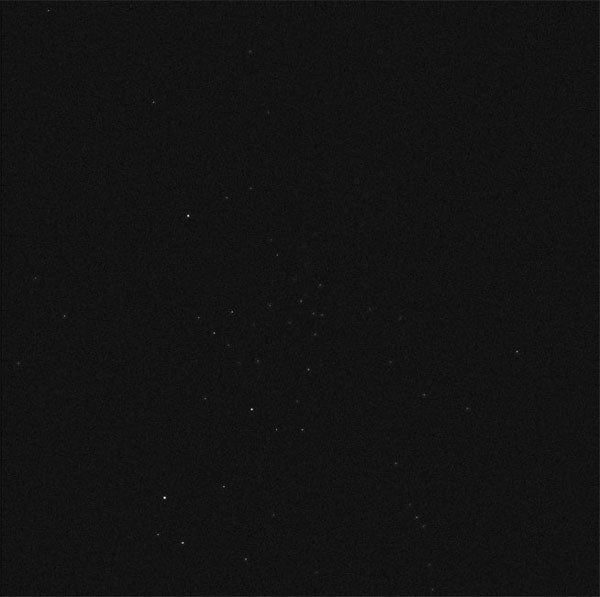Astronomers using the 10-meter Keck II telescope in Hawaii have confirmed that a troupe of about 1,000 small, dim stars just outside the Milky Way constitute the darkest known galaxy, as well as something else — a treasure-trove of ancient stars.
By “dark,” astronomers are not referring to how much light the galaxy, called Segue 1, puts out, but the fact that the dwarf galaxy appears to have 3,400 times more mass than can be accounted for by its visible stars. In other words, Segue 1 is mostly an enormous cloud of dark matter decorated with a sprinkling of stars.
Marla Geha from Yale University in New Haven, Connecticut, Joshua Simon from the Carnegie Institution in Washington, D.C., and their colleagues made the initial announcement of the “darkest galaxy” 2 years ago. This original claim was based on data from the Sloan Digital Sky Survey and the Keck II telescope. Those observations indicated the stars were all moving together and were a diverse group, rather than simply a cluster of similar stars that had been ripped out of the nearby and more star-rich Sagittarius dwarf galaxy. A competing group of astronomers at Cambridge University in the United Kingdom were, however, not convinced.
So Simon, Geha, and their group returned to Keck and went to work with the telescope’s Deep Extragalactic Imaging Multi-Object Spectrograph (DEIMOS) to measure how the stars move not just in relation to the Milky Way, but also in relation to each other.
“That tells you Segue 1 must have much more mass to accelerate the stars to those velocities,” Geha explained.
The mass required to cause the different star velocities seen in Segue1 has been calculated at 600,000 solar masses. But there are only about 1,000 stars in Segue 1, and they are all close to the mass of our Sun, Simon said. Virtually all of the remainder of the mass must be dark matter.
Stellar Old Folks Home
Equally exciting news from Segue 1 is its unusual collection of nearly primordial stars. One way to tell how long ago a star formed is by its heavy element content, which can be gleaned from the characteristic absorption features in the star’s spectrum. Very old or primitive stars come from a time when the universe was young and few large stars had yet grown old enough to fuse lightweight atoms like hydrogen and helium into heavier elements like iron and oxygen. Early, and therefore ancient, stars that formed from early gas clouds are therefore low in heavy elements.
The researchers managed to gather iron data on six stars in Segue 1 with the Keck II telescope, and an Australian team measured a seventh Segue 1 star using the Very Large Telescope. Of those seven, three proved to have less than one-2,500th as much iron as our own Sun.
“That suggests these are some of the oldest and least evolved stars that are known,” said Simon.
“In Segue 1, we already have 10 percent of the total in the Milky Way,” Geha said. “For studying these most primitive stars, dwarf galaxies are going to be very important.”
Dark Matter Demolition Derby
The confirmation of the large concentration of dark matter in Segue 1 underscores the importance of other research that has focused on Segue 1. In particular, some researchers have been looking with the space-based Fermi Gamma Ray Telescope in hopes of catching sight of a faint glimmer of gamma rays that could be created, theoretically, by the collision and annihilation of pairs of dark matter particles.
So far, the Fermi telescope has not detected anything of the sort, which isn’t entirely surprising and doesn’t mean the dark matter isn’t there, said Simon.
“The current predictions are that the Fermi telescope is just barely strong enough or perhaps not quite strong enough to see these gamma rays from Segue 1,” Simon explained. So there are hopes that Fermi will detect at least the hint of a collision. “A detection would be spectacular,” said Simon. “People have been trying to learn about dark matter for 35 years and not made much progress. Even a faint glow of the predicted gamma rays would be a powerful confirmation of theoretical predictions about the nature of dark matter.”
In the meantime, astronomers suspect there are others, perhaps even darker dwarf galaxies, hovering around the Milky Way waiting to be discovered. “We’d like to find more objects like Segue 1,” Simon said.












